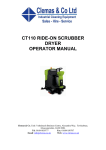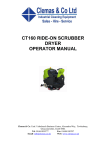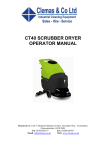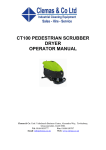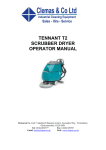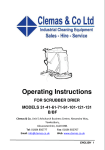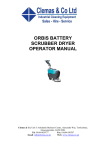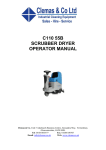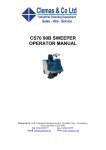Download TENNANT T7 SCRUBBER DRYER OPERATOR
Transcript
TENNANT T7 SCRUBBER DRYER OPERATOR MANUAL Clemas & Co. Unit 5 Ashchurch Business Centre, Alexandra Way, Tewkesbury, Gloucestershire, GL20 8NB. Tel: 01684 850777 Fax: 01684 850707 Email: [email protected] Web: www.clemas.co.uk SAFETY PRECAUTIONS The safety labels appear on the machine in the locations indicated. If these or any label becomes damaged or illegible, install a new label in its place. BATTERY CHARGING LABEL -- LOCATED ON THE SEAT PANEL FLAMMABLE SPILLS LABEL -- LOCATED ON THE SEAT PANEL FOR SAFETY LABEL -LOCATED ON THE SEAT PANEL FLAMMABLE MATERIALS LABEL -LOCATED UNDER THE SOLUTION FILL PORT AND NEXT TO FOOT PEDALS ELECTRICAL COMPONENTS, USE GROUNDING STRAP BEFORE OPENING PANEL LABEL -- LOCATED ON ELECTRICAL PANEL UNDER THE SEAT 3 T7 331051 (11--04) Home Find... Go To.. OPERATION OPERATION MACHINE COMPONENTS D B I P C Q E R S J A K G N H O M L F A. B. C. D. E. F. G. H. I. J. Recovery tank drain hose Recovery tank cover Recovery tank Operator seat Batteries Rear squeegee Side squeegee Scrub head Steering wheel Solution tank K. Tool Box or optional FaST--PAK compartment L. Solution tank fill cap M. Solution tank drain hose N. Squeegee hose O. Front solution tank cover P. Hour meter Q. Circuit breakers R. 100 A Fuse S. Battery charging connector 4 T7 331051 (11--04) Home Find... Go To.. OPERATION CONTROLS AND INSTRUMENTS F H E G A D C B R J L N P Q I K A. B. C. D. E. F. G. H. I. J. K. L. M. N. O. P. Q. R. M 0 Solution tank empty indicator Recovery tank full indicator Battery charge level indicators Fault indicator Emergency Stop Button Directional switch Horn button On/Off key switch One Step scrub button FaST button (option) Vacuum fan / squeegee button Brush Pressure increase button (+) Brush Pressure decrease button (--) Solution increase button (+) Solution decrease button (--) Brake pedal Propel pedal Control panel cover 5 T7 331051 (11--04) Home Find... Go To.. OPERATION FOAM SCRUBBING SYSTEM (FAST MODE) HOW THE MACHINE WORKS The machine solution tank, scrub brushes, squeegee, vacuum fan, and recovery tank work together to effectively clean dirty floors. Water and detergent from the solution tank flow to the floor through a solution valve. The brushes use the detergent and water solution to scrub the floor clean. As the machine propels forward, the squeegee wipes the dirty solution from the floor. The suction created by the vacuum fan then draws the dirty solution from the squeegee into the recovery tank. Unlike conventional scrubbing, the optional FaST (Foam Scrubbing Technology) system operates by injecting the FaST--PAK concentrate agent into the system with a small amount of water and air. This mixture creates a large volume of expanded wet foam. The expanded foam mixture is then dispersed onto the floor while the machine is scrubbing. When the squeegee picks up the mixture, the patented foaming agent has collapsed and is recovered into the recovery tank. The steering wheel controls the path of the machine travel. The directional switch controls the forward or reverse direction of the machine. The propel pedal controls the speed of the machine. The brake pedal slows and stops the machine. The buttons on the control panel control the machine scrubbing functions. The One Step Scrub button turns the preset scrub functions on and off. The FaST button controls use of the Foam scrubbing system. The vacuum fan / squeegee button turns the vacuum fan on/off and raises and lowers the squeegee. The brush pressure buttons control the scrub brush pressure, and the solution buttons control the solution flow. There are two different types of scrub heads available, cylinderical and disk. Both scrub heads are available in two different widths. The Disk scrub head is available in 650 mm (26 in) wide and 800 mm (32 in) wide. The Cylinderical scrub head is available in 700 mm (28 in) wide and 800 mm (32 in) wide. NOTE: The amount and type of soilage play an important role in determining the type of brushes or pads to use. For specific recommendations, see the BRUSH INFORMATION section of this manual or contact a Tennant representative. The FaST system can be used with all double scrubbing and heavy duty scrubbing applications. Using the FaST system improves safety and can increase productivity by 30% by reducing your dump/fill cycle. It will also reduce chemical usage and storage space. One FaST--PAK of concentrated agent can scrub up to 90,000 m2 (1 million square feet). NOTE: Do not use the FaST system with conventional cleaning detergents in the solution tank. Drain, rinse and refill the solution tank with clear cool water before operating the FaST system. Conventional cleaning detergents may cause failure to the FaST system. 6 T7 331051 (9--06) Home Find... Go To.. OPERATION BRUSH INFORMATION MACHINE SETUP For best results, use the correct brush type for the cleaning application. The following are recommended brush applications. ATTACHING SQUEEGEE ASSEMBLY 1. Stop machine on a level surface. 2. Turn the machine ON/OFF key switch off. FOR SAFETY: Before leaving or servicing machine, stop on level surface, and turn off machine. 3. Place the rear squeegee under the squeegee mount bracket and fasten with the two knobs. The squeegee deflection is set at the factory. If the squeegee blade needs adjustments, see ADJUSTING REAR SQUEEGEE BLADE DEFLECTION section of this manual. Non-scuff polypropylene brush (Cylinderical and Disk) -- This brush uses a softer, general purpose polypropylene bristle to lift lightly compacted soilage without scuffing high-gloss coated floors. Nylon brush (Cylinderical and Disk) -- Softer nylon bristles are recommended for scrubbing coated floors. Cleans without scuffing Super abrasive bristle brush (Cylinderical and Disk) -- Nylon fiber impregnated with abrasive grit to remove stains and soilage. Strong action on any surface. Performs well on buildup, grease, or tire marks. Heavy duty stripping pad -- This black pad is for stripping floors. Cuts through old heavy finishes easier to prepare the floor for recoating. INSTALLING BRUSHES/PADS To install the brushes or pad, see REPLACING DISK SCRUB BRUSHES OR PAD DRIVER or REPLACING CYLINDERICAL SCRUB BRUSHES section of this manual. Stripping pad -- This brown pad is for stripping floors. Quickly and easily cuts through old finish to prepare the floor for recoating. Scrubbing pad -- This blue pad is for scrubbing floors. Removes dirt, spills, and scuffs. Leaves a clean surface ready for recoating. Buffing pad -- This red pad is for buffing floors. Quickly cleans and removes scuff marks while polishing the floor to a high gloss. Polishing pad -- This white pad is for polishing floors. Maintains a high gloss. Use for buffing very soft finishes and lower traffic areas, and polishing soft waxes on wood floors. 7 T7 331051 (9--06) Home Find... Go To.. OPERATION FILLING THE SOLUTION TANK The machine is equipped with a fill port at the rear of the machine. MACHINE OPERATION PRE--OPERATION CHECKLIST - Check the battery fluid and charge level. - Check the tank cover seals for damage and wear. - Clean the vacuum fan inlet filter. - Check the condition of the scrubbing brushes. Remove any string, banding, plastic wrap, or other debris wrapped around them. - Cylinderical brushes: Check that the debris tray is empty and clean. WARNING: Flammable materials can cause an explosion or fire. Do not use flammable materials in tank(s). FOR CONVENTIONAL SCRUBBING: Open the solution tank fill port and partially fill it with water (not to exceed 60°C / 140°F). Pour the required amount of detergent into the solution tank according to mixing instructions on the bottle. Then continue filling the solution tank with warm water until the water level is just below the fill port. FOR SAFETY: When using machine, follow mixing and handling instructions on chemical containers. FOR FOAM SCRUBBING (FaST MODE) : FILL THE TANK WITH ONLY CLEAN COOL WATER (less than 21°C / 70°F). DO NOT use hot water or add any conventional floor cleaning detergents or FaST system failure may result. NOTE: When filling the solution tank with a bucket, make sure that the bucket is clean. Do not use the same bucket for filling and draining the machine. ATTENTION: For Conventional Scrubbing, only use recommended cleaning detergents. Machine damage due to improper detergent usage will void the manufacturer’s warranty. - Check the squeegees for damage, wear and for deflection adjustment. - Check the vacuum hose for debris or blockage. - Drain and clean the recovery tank. - Check the brakes and steering for proper operation. - Check the service records to determine maintenance requirements. - FaST Scrubbing: Check the FaST--PAK (option) concentrate agent level. Replace carton as needed. See the INSTALLING THE FaST--PAK AGENT section of the manual. - FaST Scrubbing: Ensure that all conventional cleaning agents are drained and rinsed from the solution tank. - FaST Scrubbing: Ensure that the solution tank is filled with clear cool water only. BEFORE OPERATING Pick up oversized debris before scrubbing. Pick up pieces of wire, string, twine, etc., that could become wrapped around the scrub brush. Plan the scrubbing in advance. Try to arrange long runs with minimum stopping and starting. Do an entire floor or section at one time. Pre--sweep the area to prevent streaking. 8 T7 331051 (9--06) Home Find... Go To.. OPERATION SETTING SCRUB MODES Before scrubbing, determine which scrub mode will be used (FaST or conventional). Then set the scrub brush pressure and if conventional scrubbing, adjust the solution flow levels. SETTING FaST BUTTON The FaST button enables the FaST system to come on when the One Step Scrub button is on. The light next to the button will come on when it is in this mode. NOTE: The solution flow cannot be adjusted when the machine is in the FaST mode. SETTING SOLUTION FLOW LEVEL (CONVENTIONAL SCRUBBING ONLY) NOTE: The solution flow cannot be adjusted when the machine is in the FaST mode. Under normal soilage conditions the solution flow level should be set to the lowest setting (the bottom light). Under heavy grime conditions, the solution flow level should be set to the higher settings (middle or top lights). Travel speed and floor conditions will affect scrubbing performance. With the One Step Scrub button on, press either Solution increase button (+) or Solution decrease button (--) to set the solution flow level for the surface being cleaned. The new solution flow setting will default to this setting when the machine is powered on or off. SETTING BRUSH PRESSURE Under normal conditions, the brush pressure should be set to the minimum setting (the bottom light). Under heavy grime conditions, the brush pressure should be set to the maximum setting (the top light). Travel speed and floor conditions will affect scrubbing performance. With the One Step Scrub button on, press either the Brush Pressure increase button (+) or the Brush Pressure decrease button (--) to set the scrubbing pressure for the surface being cleaned. The new pressure setting will default to this setting when the machine is powered on or off. ECONOMY SETTING The machine will operate for a longer time if the Brush Pressure and Solution Flow settings are in the Economy setting. The bottom lights of the Brush Pressure and Solution Flow settings are on when the machine is in the Economy setting. 9 T7 331051 (11--04) Home Find... Go To.. OPERATION SCRUBBING FOR SAFETY: Do not operate machine, unless operator manual is read and understood. 1. Turn the On/Off key switch on. 3. Place the directional switch in the direction the machine is to be moved (forward or reverse). NOTE: The machine can scrub in both forward or reverse. The horn will sound when in reverse. NOTE: Make sure the scrub modes / settings are set before scrubbing. 2. Press the One Step Scrub button. The light on the button is illuminated. All the preset scrubbing functions will turn on. NOTE: The squeegee automatically raises when the machine is driven backwards. This prevents damaging the squeegee. When the machine is placed in reverse, the vacuum fan will shut off after a short delay. 4. Press the propel pedal to begin scrubbing. NOTE: Open the control panel cover to adjust the Brush Pressure and Solution Flow Setting while scrubbing if necessary. WARNING: Flammable materials or reactive metals can cause an explosion or fire. Do not pick up. NOTE: DO NOT turn the FaST system on during conventional scrubbing. Conventional cleaning detergents may cause the FaST injection system to fail. Drain, rinse, and refill solution tank with cool clean water before operating the FaST system. 5. Release the propel pedal to stop the machine. Scrubbing functions stop and the automatic park brake will engage when the machine stops. 10 T7 331051 (11--04) Home Find... Go To.. OPERATION 6. The Brake pedal can be used to control the machine if quicker stopping is needed or if operating on an incline. Do not operate machine on inclines exceeding 7% (4_) when scrubbing. FOR SAFETY: When using machine, go slow on inclines and slippery surfaces. DOUBLE SCRUBBING For heavily soiled areas, use the double scrubbing method. Disk brushes: Before double scrubbing, remove the side squeegees to keep them from channeling water while double scrubbing. To remove the side squeegees, lower the scrub head, then pull the pins on the front and rear ends of the squeegees. If the machine is equipped with the accessory basket, you may hang the side squeegees from the hooks. 7. Press the One Step Scrub button to stop scrubbing. The light next to the One Step Scrub button will turn off and the scrubbing functions will turn off after a short delay. To double scrub, press the One Step Scrub button, then the vacuum fan button. The light above the vacuum fan button will turn off, the squeegee will raise and the vacuum fan will stop operating. Then scrub the area. Let the cleaning solution set on the floor for 3--5 minutes. 11 T7 331051 (9--06) Home Find... Go To.. OPERATION Place the side squeegees back on to the machine before scrubbing the floor the second time. NOTE: It is easier to put the side squeegees back on to the machine with the scrub head partially lowered. This allows clearance to install the pins. WATER PICKUP MODE (NO SCRUBBING) The machine can be used to pick up water or non--flammable liquid spills without scrubbing. To pick up water or non--flammable liquid spills, check to make sure that the One Step Scrub button is not activated. The light next to the One Step Scrub button must be off. Press the vacuum fan button again to lower the squeegee and to turn on the vacuum fan. The light above the vacuum fan button will come on. Then scrub the floor a second time picking up the cleaning solution. WARNING: Flammable materials or reactive metals can cause an explosion or fire. Do not pick up. NOTE: When scrubbing the area a second time, you can turn off the solution flow by pressing the Solution decrease button (--) repeatedly until all lights above the button are off. WARNING: Flammable materials or reactive metals can cause an explosion or fire. Do not pick up. Then press the vacuum fan button. The light above the vacuum fan button will turn on, the squeegee will lower and the vacuum fan will start operating. Then pick up the water or non--flammable liquid spill. 12 T7 331051 (11--04) Home Find... Go To.. OPERATION WHILE OPERATING THE MACHINE EMERGENCY STOP BUTTON Drive as straight a path as possible. Avoid bumping into posts or scraping the sides of the machine. Overlap the scrub paths by several centimeters (a few inches). The Emergency Stop Button halts all power to the machine in case of an emergency. Press the button to halt the machine power. To restart the machine, turn the Emergency Stop Button to the right. Then turn the on/off switch to the off position and then to the on position. Avoid turning the steering wheel too sharply when the machine is in motion. The machine is very responsive to the movement of the steering wheel. Avoid sudden turns, except in emergencies. When scrubbing dead end aisles, start at the closed end of the aisle and scrub out towards the opening. NOTE: This button should not be used for normal stopping as premature wear to the parking brake may occur. Adjust the machine speed, brush pressure, and solution flow as required when scrubbing. Use the minimal brush pressure and solution flow settings as possible. Use the FaST system for the best results. Keep the machine moving to prevent damaging floor finishes. If poor scrubbing performance is observed, stop scrubbing and refer to MACHINE TROUBLESHOOTING. Conventional Scrubbing: Pour a recommended foam control solution into the recovery tank if excessive foam appears. Change or rotate pads as necessary. HOUR METER The hour meter records the number of hours the machine has been powered on. This information is useful for servicing the machine. It is located under the seat. Observe the battery discharge indicator to ensure there is adaquate charge for machine operation. Observe the solution tank indicator to ensure the solution tank is not empty. Always empty recovery tank before refilling the solution tank. Observe the recovery tank indicator to ensure the recovery is not full. Remove the key when leaving the machine unattended. Perform the Daily Maintenance Procedures after scrubbing (see MACHINE MAINTENANCE). 13 T7 331051 (11--04) Home Find... Go To.. OPERATION SOLUTION TANK EMPTY INDICATOR BATTERY DISCHARGE INDICATOR The solution tank empty indicator comes on when the solution tank is empty. When this happens, the scrub functions are disabled. If necessary, press the ONE STEP Scrub button for an additional minute of operation to pick up standing water or solution. The battery discharge indicator shows the charge level of the batteries. When the batteries are fully charged, all five lights are lit. As the batteries discharge, the lights go out until only the left light is blinking. RECOVERY TANK FULL INDICATOR The recovery tank full indicator comes on when the recovery tank is full. When this happens, the scrub functions are disabled. If necessary, press the ONE STEP Scrub button for an additional minute of operation to pick up standing water or solution. When the left light blinks, the scrubbing functions will shut off to alert the operator of the battery condition. The machine will still propel when the light is blinking. Recharge the batteries when the light blinks. If necessary, press the ONE STEP Scrub button for an additional minute of operation to pick up standing water or solution. NOTE: Do not charge batteries more often than necessary. Excessive charging could reduce the life of the batteries. It is best to charge the batteries only when the left light indicates that the battery needs charging. See BATTERIES in the MAINTENANCE section. NOTE: The blinking left battery discharge light will not reset from blinking until the batteries are fully charged. 14 T7 331051 (11--04) Home Find... Go To.. OPERATION FAULT INDICATOR The fault indicator light (shown in upper right) comes on when there a fault is detected in the propelling motor, vacuum fan motor, or brush motors. Refer to the table below to determine the cause for the fault or failure. Indicator(s) Fault Light blinks Cause(s) Propel motor is overloaded Fault Light and bottom Brush Pressure Light both blink Fault Light and top Brush Pressure Light both blink Fault Light and Vacuum Fan Light both blink Right Brush Motor is overloaded (possibly from string or banding wrapped around motor) Left Brush Motor is overloaded (possibly from string or banding wrapped around motor) Vacuum Fan Motor is overloaded Remedy Contact Tennant service representative Remove string / banding from Right brush motor or Contact Tennant service representative Remove string / banding from Left brush motor or Contact Tennant service representative Contact Tennant service representative 15 T7 331051 (11--04) Home Find... Go To.. OPERATION CIRCUIT BREAKERS FUSES Circuit breakers are resettable electrical circuit protection devices that stop the flow of current in the event of a circuit overload. Once a circuit breaker is tripped, allow breaker to cool and then press the reset button to manually reset the breaker. The fuse is a one-time protection device designed to stop the flow of current in the event of a circuit overload. The 100 A fuse is located inside the battery compartment near the hourmeter. It protects the propel circuit. NOTE: Always replace the fuse with a fuse of the same amperage. If the overload that caused the circuit breaker to trip is still there, the circuit breaker will continue to stop current flow until the problem is corrected. HAZARD LIGHT SWITCH (OPTION) The circuit breakers are located inside the battery compartment next to the hour meter. The Hazard Light Switch operates the optional hazard light. The chart shows the circuit breakers and the electrical components they protect. Circuit Breaker Rating Circuit Protected CB1 5A Instrument Panel -- power CB2 15 A Accessories 16 T7 331051 (9--06) Home Find... Go To.. OPERATION DRAINING AND CLEANING THE TANKS When cleaning is finished, or when the recovery tank full indicator comes on, the recovery tank should be drained and cleaned. The solution tank then can be filled again for additional cleaning. 1. Drive the machine to a solution disposal drain. 2. Turn the machine ON/OFF key switch off. FOR SAFETY: Before leaving or servicing machine, stop on level surface, and turn off machine. 3. Tilt the operator seat forward and hook the seat latch into place to hold up the seat. 4. Remove the recovery tank drain hose. While holding the hose up, remove the plug, then slowly lower the drain hose to the floor drain or sink. 6. Rinse the float sensor located inside the recovery tank. 7. Replace the recovery tank drain hose cap and mount the drain hose back onto the mounting clip after the tank is drained. 8. Remove and clean the vacuum fan filter. Clean the filter with a damp cloth or low pressure water hose if dirty. Allow the vacuum fan filter to dry completely before reinstalling it in the machine. 5. Lift the recovery tank cover. Flush the inside of the recovery tank with clean water. WARNING: Flammable materials can cause an explosion or fire. Do not use flammable materials in tank(s). NOTE: DO NOT use steam to clean tanks. Excessive heat can damage tanks and components. 17 T7 331051 (11--04) Home Find... Go To.. OPERATION 9. Close the recovery tank cover. 10.Remove the solution tank drain hose. While holding the hose up, remove the plug, then slowly lower the drain hose to the floor drain or sink. 13. Carefully push the recovery tank forward to close the solution tank. 14. Unhook the seat latch and lower the operator seat. 11. Tilt the recovery tank back to access the solution tank. Make sure the recovery tank is empty before tilting. 15. Clean the front of the solution tank through the front access port located under the front solution tank cover. Wipe the bottom of the cover and the tank seal before replacing the cover. 12. Flush the solution tank and rinse the float sensor located inside the back part of the solution tank. Rinse the screen filter on the bottom of the tank. 18 T7 331051 (9--06) Home Find... Go To.. OPERATION 16. Cylinderical scrub head: Remove and clean the debris tray. Place the tray back in the scrub head when finished. 17. Replace the solution tank drain hose cap and mount the drain hose back onto the mounting clip after after the tank is drained. PROPEL SYSTEM TROUBLESHOOTING The audio alarm (horn) will sound and/or warning lights will come on when a propelling system fault or failure is detected. The machine will stop propelling when this happens. Refer to the table below to determine the cause for the fault or failure. Indicator(s) Horn repeatedly beeps 2 times Horn repeatedly beeps 4 times Horn repeatedly beeps 5 times Horn repeatedly beeps 6 times Horn repeatedly beeps 7 times Horn repeatedly beeps 8 times Horn repeatedly beeps 9 times Fault Light blinks Cause(s) Propel pedal depressed without operator in seat ON/OFF key switch is turned on while propel pedal is engaged Failure in the Throttle system has occurred Failure in the Brake system has occurred Failure in the Parking Brake system has occurred Emergency Stop Button is engaged Remedy Sit in seat when operating machine ON/OFF key switch is turned on while battery charger is plugged into machine Propel motor is overloaded Unplug battery charger before starting machine Release the propel pedal before turning key on Contact Tennant service representative Contact Tennant service representative Contact Tennant service representative Reset Emergency Stop Button Contact Tennant service representative 19 T7 331051 (9--06) Home Find... Go To.. OPERATION MACHINE TROUBLESHOOTING Problem Trailing g water--poor p or no water t pickup i k Vacuum fan will not turn on Cause Remedy Vacuum fan turned off Turn vacuum fan on Worn squeegee blades Rotate or replace squeegee blades Squeegee out of adjustment Adjust squeegee Vacuum hose clogged Flush vacuum hoses Vacuum fan filter dirty Clean vacuum fan filter Vacuum fan cover seals worn Replace seals Debris caught on squeegee Remove debris Vacuum hose to squeegee or recovery tank disconnected or damaged Reconnect or replace vacuum hose Recovery tank cover not completely closed Check for obstructions and close cover Vacuum fan switch turned off Turn vacuum switch on Recovery tank full Foam filling g recoveryy tank Drain recovery tank Empty recovery tank Use less detergent Recovery tank sensor dirty or stuck Clean or replace sensor Little or no solution flow to th floor the fl (Conventional (C ti l Scrubbing Mode) Solution tank empty Fill solution tank Solution flow turned off Turn solution flow on Solution supply lines plugged Flush solution supply lines 20 T7 331051 (11--04) Home Find... Go To.. OPERATION Problem Poor scrubbing g performance p FaST System does not operate t Cause Remedy One Step Scrub button not on Turn One Step Scrub button on Improper detergent or brushes used Contact Tennant service representative Recovery tank full Empty recovery tank Solution tank empty Fill solution tank Debris caught on scrub brushes or pads Remove debris Worn scrub brush Replace scrub brush Broken or loose brush drive belt (Cylinderical models) Replace or tighten belt Brush pressure set too light Increase brush pressure Low battery charge Charge batteries until the charger automatically turns off FaST switch is turned off Turn on the FaST swiitch Accessory circuit breaker tripped Reset circuit breaker Clogged FaST--PAK supply hose and/or connector Soak connector and hose in warm water and clean FaST--PAK carton is empty or not connected Replace FaST--PAK carton and/or connect supply hose FaST system is not primed To prime, operate the FaST solution system for a few minutes Clogged filter screen Drain solution tank, remove and clean filter screen Faulty solution pump Replace solution pump 21 T7 331051 (9--06) Home Find... Go To.. MAINTENANCE MAINTENANCE 9 3 8 7 3 1 3 10 5 6 10 3 4 11 2 1 14 12 13 22 T7 331051 (9--06) Home Find... Go To.. MAINTENANCE MAINTENANCE CHART Interval Dailyy Key Description 1 Side and rear squeegees q g 2 8 Scrub brushes / pads Recovery tank 9 7 Vacuum fan filter FaST--PAK supply hose and connector (option) Debris tray (Cylinderical brushes) Battery cells (Lead acid batteries) Disk scrub head floor skirt Cylinderical brushes 12 4 50 Hours 11 13 3 100 Hours 14 200 Hours 4 500 Hours 9 5 6 10 Vacuum Fan and tank seals Cylinderical brush drive belts Battery terminals and cables Vacuum fan motor(s) Scrub brush motors Propelling motor Tires No. of Lubricant/ Service Fluid Points Procedure Check for damage and wear -3 Check deflection and leveling -6 Check for damage, wear, debris -2 Clean tank, screen filter, and float -1 sensor Clean -1 Clean and connect hose to stor-1 ing plug when not in use Clean -1 Check electrolyte level DW 3 Check for damage and wear Check taper and rotate front to rear Check for damage and wear --- 2 2 -- 3 Check tension -- 2 Check and clean -- 12 Check motor brushes Check motor brushes Check motor brushes Check for damage and wear ----- 1 2 1 3 LUBRICANT/FLUID DW . . . . Distilled water 23 T7 331051 (9--06) Home Find... Go To.. MAINTENANCE BATTERIES LEAD ACID BATTERIES The batteries are designed to hold their power for long periods of time. The lifetime of the batteries is limited to number of charges the batteries receive. To get the most life from the batteries, recharge them immediately when the battery discharge indicator begins to blink. Check the electrolyte level in each battery cell before and after charging, and after every 50 hours of operation. Never add acid to the batteries. Add distilled water only. Always keep the battery caps on, except when adding water or taking hydrometer readings. FOR SAFETY: When servicing machine, wear protective gloves when handling batteries or battery cables. Avoid contact with battery acid. Using a hydrometer, measure the specific gravity to determine the charge level and condition of the batteries. If one or more of the battery cells test lower than the other battery cells (0.050 or more), the cell is damaged, shorted, or is near failure. Completely recharge the batteries and then retest. After every 200 hours of use check for loose battery connections and clean the surface of the batteries, including terminals and cable clamps, using a strong solution of baking soda and water. Brush the solution sparingly over the battery tops. Do not allow any baking soda solution to enter the batteries. Use a wire brush to clean the terminal posts and the cable connectors. Wipe off all cleaning solution residue. After cleaning, apply a coating of clear battery post protectant to the terminals and the cable connectors. Keep the tops of the batteries clean and dry. Objects made of metal can potentially short circuit the batteries. Keep all metallic objects off the batteries. Replace any worn or damaged wires. Replace any defective batteries. To dispose of batteries, contact a battery dealer or your Tennant Service representative. 04380 GEL BATTERIES The Gel batteries are maintenance free and do not need to have the electrolyte level checked. 24 T7 331051 (9--06) Home Find... Go To.. MAINTENANCE NOTE: Do not take readings immediately after adding distilled water. If the water and acid are not thoroughly mixed, the readings may not be accurate. Check the hydrometer readings against the following chart to determine the remaining battery charge level: SPECIFIC GRAVITY at 27_ C (80_F) BATTERY CHARGE 1.265 100% Charged 1.223 75% Charged 1.185 50% Charged 1.148 25% Charged 1.110 Discharged NOTE: If the readings are taken when the battery electrolyte is any temperature other than 27_ C (80_ F), the reading must be temperature corrected. Add or subtract to the specific gravity reading 0.004, 4 points, for each 6_ C(10_ F) above or below 27_C(80_ F). CHARGING THE BATTERIES WITH OFF--BOARD CHARGER 1. Drive the machine to a flat, dry surface. NOTE: Make sure the area is well ventilated. 4. Lead acid batteries: Check the water level in all battery cells. If the level is low, add just enough distilled water to cover the plates. DO NOT OVERFILL. The batteries can overflow during charging due to expansion. NOTE: Make sure the battery caps are in place while charging. FOR SAFETY: When servicing machine, wear protective gloves when handling batteries or battery cables. Avoid contact with battery acid. 5. Plug the charger connector into the machine battery charging connector. 2. Turn the machine ON/OFF key switch off. FOR SAFETY: Before leaving or servicing machine, stop on level surface, and turn off machine. WARNING: Batteries emit hydrogen gas. Explosion or fire can result. Keep sparks and open flame away. Keep covers open when charging. 3. Tilt the operator seat forward and hook the seat latch into place to hold up the seat 25 T7 331051 (9--06) Home Find... Go To.. MAINTENANCE 6. Plug the battery charger into the wall outlet. NOTE: If the red “ABNORMAL CYCLE” lamp lights when the TENNANT charger is plugged into a wall outlet, the charger cannot charge the battery and there is something wrong with the battery. ELECTRIC MOTORS The carbon brushes on the vacuum fan motor, the propelling motor, and the scrub brush motors should be inspected after the initial 500 hours of machine operation and then every 100 hours after the initial 500 hours. BELTS (Cylinderical Models) 07224 7. The TENNANT charger will start automatically. When the batteries are fully charged, the TENNANT charger will automatically turn off. The two brush drive belts are located on the cylindrical brush scrub head. The belts drive the cylindrical brushes. Proper belt tension is a 6 mm (0.25 in) deflection from a force of 2.3 to 2.5 kg (5.0 to 5.4 lb) at the belt midpoint. Check and adjust the belt tension every 100 hours of operation. NOTE: Do not disconnect he charger’s DC cord from the machine’s battery charging connector when the charger is operating. Arcing may result. If the charger must be interrupted during charging, disconnect the AC power supply cord first. 8. After the charger has turned off, unplug the charger from the machine battery charging connector. 9. Lead acid batteries: Check the electrolyte level in each battery cell after charging. If needed, add distilled water to raise the electrolyte level to about 12 mm (0.4 in) below the bottom of the sight tubes. 10. Unhook the seat latch and lower the operator seat. 26 T7 331051 (07--07) Home Find... Go To.. MAINTENANCE REPLACING DISK BRUSHES OR PAD DRIVER SCRUB BRUSHES AND PADS The machine can be equipped with either disk or cylindrical scrub brushes, or cleaning pads. Check scrub brushes daily for wire or string tangled around the brush or brush drive hub. Also check for brushes damage and wear. DISK BRUSHES The scrub brushes should be replaced if a large number of bristles are missing or if bristle length is less than 10 mm (0.38 in). 1. Stop machine on a level surface. Make sure the scrub head is in the raised position. 2. Turn the machine ON/OFF key switch off. FOR SAFETY: Before leaving or servicing machine, stop on level surface, and turn off machine. 3. Pull the pin from the side squeegee retainer pivot. Cleaning pads must be placed on pad drives before they are ready to use. The cleaning pad is held in place by a pad holder. Cleaning pads need to be cleaned immediately after use with soap and water. Do not wash the pads with a pressure washer. Hang pads, or lie pads flat to dry. NOTE: Always replace brushes and pads in sets. Otherwise one brush or pad will be more aggressive than the other. 4. Open the side squeegee retainer pivot toward the front of the machine, then pull the side squeegee toward the rear of the machine to access the scrub brushes or pads. 27 T7 331051 (9--06) Home Find... Go To.. MAINTENANCE 5. Pull the scrub brush/pad driver downward to remove it from the drive hub. REPLACING DISK PADS 1. Remove the pad driver from the machine. 2. Squeeze the spring clip together to remove the center disk. 6. Place the new scrub brush/pad driver onto the drive hub. Ensure that it is securely mounted onto the brush drive hub. 3. Flip or replace the scrub pad, center the scrub pad on the pad driver. Then reinstall the center disk to secure the pad in place on the pad driver. 7. Close the side squeegee and the retainer pivot, then insert the pin. NOTE: Be sure the pin is inserted completely through the bottom. 4. Reinsert the pad driver into the machine. 28 T7 331051 (9--06) Home Find... Go To.. MAINTENANCE CYLINDERICAL BRUSHES Check the brush taper and rotate the brushes from front-to-rear every 50 hours of machine operation for maximum brush life and best scrubbing performance. 4. Remove idler plate from the scrub head by pressing the spring tab downward. The cylindrical brushes should be replaced if large amounts of bristles are missing, or if the remaining bristle length is less than 15 mm (0.62 in). NOTE: Replace worn brushes in pairs. Scrubbing with brushes of unequal bristle length will result in diminished scrubbing performance. REPLACING OR ROTATING CYLINDERICAL BRUSHES 1. Stop machine on a level surface. Make sure the scrub head is in the raised position. 2. Turn the machine ON/OFF key switch off. 5. Pull the old brush out of the scrub head. 6. Attach the idler plate to the new or rotated brush on the end that has the double row of bristles. Install the brush. FOR SAFETY: Before leaving or servicing machine, stop on level surface, and turn off machine. 3. Remove the cotter pin that holds the side squeegee in place. Swing the squeegee away from the scrub head. 7. Push down on the door to catch the door in the scrub head, then pull up on the door to latch it into the spring. 8. Repeat for the other brush on the other side of the scrub head NOTE: Each side of the scrub head is stamped with a letter. The idler door of that side of the scrub head is stamped with the same letter. Make sure the letter on the door matches the letter on the scrub head when replacing the doors. 29 T7 331051 (9--06) Home Find... Go To.. MAINTENANCE CHECKING CYLINDERICAL BRUSH PATTERN 1. Apply chalk, or a similar marking material, to a smooth and level section of the floor. 8. If the width of the brushes is not the same, see ADJUSTING CYLINDERICAL BRUSH WIDTH section of this manual. NOTE: If chalk or other material is not available, allow the brush to spin on the floor for two minutes. A polish mark will remain on the floor. 2. Raise the scrub head, then position the brushes over the chalked area. 3. Block the front or rear wheels to prevent the machine from moving. 4. Lower the scrub head in the chalked area. Slowly press down on the directional pedal until the brushes begin to sweep. Allow the machine to sweep in the same place for 15 to 20 seconds. 5. Raise the scrub head and drive the machine away from the chalked area. FOR SAFETY: Before leaving or servicing machine, stop on level surface, and turn off machine. 6. Observe the brush patterns. If the brush pattern is the same width across the entire length of each brush and both brushes are the same width, no adjustment is necessary. 10653 ADJUSTING CYLINDERICAL BRUSH TAPER FOR SAFETY: Before leaving or servicing machine, stop on level surface, and turn off machine. 1. Stop machine on a level surface. Make sure the scrub head is in the raised position. 2. Turn the machine ON/OFF key switch off. FOR SAFETY: Before leaving or servicing machine, stop on level surface, and turn off machine. 3. Remove the cotter pin that holds the side squeegee in place. Swing the squeegee away from the scrub head. 10355 7. If the brush patterns are tapered, see ADJUSTING CYLINDERICAL BRUSH TAPER section of this manual. 10652 30 T7 331051 (07--07) Home Find... Go To.. MAINTENANCE 4. Remove idler plate from the scrub head by pressing the spring tab downward. ADJUSTING CYLINDERICAL BRUSH WIDTH 1. Stop machine on a level surface. Make sure the scrub head is in the lowered position. 2. Turn the machine ON/OFF key switch off. FOR SAFETY: Before leaving or servicing machine, stop on level surface, and turn off machine. 3. Loosen the two scrub head mounting screws. 5. While holding the flat end of the idler shaft with a wrench, loosen the mounting screw on the outside of the idler door. 4. Loosen the jam nut, then adjust the brush width adjustment screw. Tighten the jam nut and the two scrub head mounting screws when finished. 6. Turn the idler shaft to raise or lower the end of the brush as needed to straighten the brush pattern. Tighten the mounting screw. 5. Check the brush patterns again and readjust as necessary until both brush patterns are the same. 7. Check the brush patterns again and readjust as necessary until both patterns are the same. 31 T7 331051 (9--06) Home Find... Go To.. MAINTENANCE REPLACING THE FaST--PAK (FaST Model) 1. Stop machine on a level surface. 2. Turn off the machine ON/OFF key switch. FOR SAFETY: Before leaving or servicing machine, stop on level surface, and turn off machine. 3. Open the FaST--PAK compartment door and slide the empty FaST--PAK approximately half way out from the FaST--PAK compartment door. 5. Remove the perforated knock outs from the new FaST--PAK carton. Do Not remove the bag from the carton. Pull out the hose connector located on the bottom of the bag and remove the hose cap from the connector. NOTE: The FaST--PAK Floor Cleaning Concentrate is specially designed for use with the FaST system scrubbing application. NEVER use a substitute. Other cleaning solutions may cause FaST system failure. 6. Insert the new FaST--PAK approximately half way into the FaST--PAK compartment. 7. Connect the FaST--PAK hose connector to the FaST supply hose connector, slide the FaST--PAK the rest of the way into the FaST--PAK compartment, and close the FaST--PAK compartment door. 8. When replacing an empty FaST--PAK carton, you must scrub with the FaST system for a few minutes before the detergent will reach its maximum foaming. FaST SUPPLY HOSE CONNECTOR 4. Squeeze the button on the FaST supply hose connector, then pull the empty FaST--PAK out from the compartment. The FaST supply hose connector is located below the FaST--PAK holder. Soak the connector in warm water if detergent buildup is visible. When a FaST--PAK carton is not installed, store the supply hose connector on the storing plug to prevent the hose from clogging. 32 T7 331051 (9--06) Home Find... Go To.. MAINTENANCE 4. Pull the rear squeegee assembly from the machine. SQUEEGEE BLADES The side squeegees control water spray and channel water into the path of the rear squeegee. The side squeegee blades are not adjustable. 5. Loosen the rear squeegee retaining band tension latch and remove the retaining band. The rear squeegee assembly channels water into the vacuum fan suction. The front blade channels the water and the rear blade wipes the floor. Check the squeegee blades daily for damage and wear. Rotate or replace the squeegee blades if the leading edge is torn or worn half-way through the thickness of the blade. Replace the side squeegee deflectors if they become worn. The rear squeegee can be adjusted for leveling and deflection. The deflection and leveling of the squeegee blades should be checked daily, or when scrubbing a different type of floor. The rear squeegee assembly can be removed from the squeegee pivot to prevent damage during transport of the machine. 6. Remove rear squeegee blade from the rear squeegee assembly. REPLACING (OR ROTATING) THE REAR SQUEEGEE BLADES 1. Stop machine on a level surface. Make sure the scrub head is in the raised position. 2. Turn the machine ON/OFF key switch off. FOR SAFETY: Before leaving or servicing machine, stop on level surface, and turn off machine. 3. Remove the squeegee suction hose from the rear squeegee assembly. Then loosen both rear squeegee assembly mounting knobs. 7. Loosen the two outer knobs on the rear squeegee assembly. Remove the front squeegee blade from the squeegee assembly. 33 T7 331051 (11--04) Home Find... Go To.. MAINTENANCE 8. Install the new front squeegee blade or rotate the existing blade to the new edge. Be sure the holes in the front squeegee blade are hooked onto the tabs on the front blade clamp. 9. Lightly tighten the two outer knobs. 12. Tighten the rear squeegee retaining band tension latch. 13.Reinstall the rear squeegee under the squeegee mount bracket and tighten all four knobs. 10. Install the new rear squeegee blade or rotate the existing blade to the new edge. Be sure the holes in the squeegee blade are hooked onto the tabs on the squeegee assembly. 14. Reinstall the squeegee suction hose onto the rear squeegee assembly. 11. Reinstall the rear squeegee retaining band onto the squeegee assembly. Be sure each of the flanges on the retaining band are seated in the cut outs in the rear squeegee assembly. 34 T7 331051 (11--04) Home Find... Go To.. MAINTENANCE REPLACING SIDE SQUEEGEE BLADES 1. Open the side squeegee. 2. Pull the old side squeegee blade from the side squeegee retainer. Slide the new blade onto the retainer. LEVELING THE REAR SQUEEGEE Leveling of the squeegee assures the entire length of the squeegee is in even contact with the surface being scrubbed. Perform this adjustment on an even and level floor. 1. Lower the squeegee and drive the machine forward a few feet. 2. Turn off the machine ON/OFF key switch. FOR SAFETY: Before leaving or servicing machine, stop on level surface, and turn off machine. 3. Look at the deflection of the squeegee over the full length of the squeegee blade. 4. If the deflection is not the same over the full length of the blade, turn the squeegee leveling bolt to make adjustments. The squeegee leveling bolt is located directly behind the squeegee suction hose. DO NOT disconnect the suction hose from the squeegee frame when leveling squeegee. 3. Close the side squeegee. ADJUSTING THE SQUEEGEE GUIDE ROLLER The squeegee guide rollers are located on both ends of the rear squeegee. The rollers guide the squeegee blade end along a wall. Loosen the nut located at the top of the guide roller and move the roller in or out to adjust how close the end of the squeegee blade is to the wall. The squeegee blade end should be further away from the wall when the floor curves up into the wall. Turn the squeegee leveling bolt counter-clockwise to increase the deflection at the ends of the squeegee. Turn the squeegee leveling bolt clockwise to decrease the deflection at the ends of the squeegee blade. 5. Drive the machine forward with the squeegee down to recheck the squeegee blade deflection if adjustments were made. 6. Readjust the squeegee blade deflection if necessary. 35 T7 331051 (9--06) Home Find... Go To.. MAINTENANCE ADJUSTING REAR SQUEEGEE BLADE DEFLECTION Deflection is the amount of curl the overall squeegee blade has when the machine moves forward. The best deflection is when the squeegee wipes the floor dry with a minimal amount of deflection. 4. If the overall squeegee blade deflection needs to be adjusted, loosen the jam nuts on the squeegee casters and adjust the height. 1. Lower the squeegee and drive the machine forward a few meters (feet). 2. Turn off the machine ON/OFF key switch. FOR SAFETY: Before leaving or servicing machine, stop on level surface, and turn off machine. 3. Look at the amount of deflection or “curl” of the squeegee blade. The correct amount of deflection is 12 mm (0.50 in) for scrubbing smooth floors and 15 mm (0.62 in) for rough floors. 5. Drive the machine forward again to recheck the squeegee blade deflection after adjustments are made. 6. Readjust the squeegee blade deflection if necessary. 12 mm (0.50 in) 03719 36 T7 331051 (11--04) Home Find... Go To.. MAINTENANCE SOLUTION TANK SEALS SKIRTS AND SEALS DISK SCRUB HEAD FLOOR SKIRT There are two solution tank seals. Check the seal for damage and wear after every 100 hours of operation. The skirt is located in front of the disc brush scrub heads. Check the skirt for damage and wear after every 50 hours of operation. A front seal is located on the bottom of the solution tank cover. A rear seal is located on the bottom of the recovery tank. The skirts should clear the floor by 0 to 6 mm (0 to .25 in) when the scrub brushes are new and the scrub head is down. TIRES RECOVERY TANK SEAL The recovery tank seal is located on the bottom of the recovery tank cover. Check the seal for damage and wear after every 100 hours of operation. The machine has three solid rubber tires: one tire is front and two are in the rear. Check the tires for damage and wear after every 500 hours of operation. 37 T7 331051 (9--06) Home Find... Go To.. MAINTENANCE PUSHING, TOWING, AND TRANSPORTING THE MACHINE PUSHING OR TOWING THE MACHINE If the machine becomes disabled, it can be pushed from the front or rear, but only tow it from the front. FOR SAFETY: When servicing machine, do not push or tow the machine on inclines with the brake disabled. Before attempting to push or tow the machine, disconnect the propel motor harness and disengage the brake. ATTENTION! Do not push or tow machine with the motor harness connected or the control board may fail. FOR SAFETY: Do not operate machine with the brake disabled. TRANSPORTING THE MACHINE When transporting the machine by trailer or truck, be certain to follow the tie--down procedure below: 1. Raise the squeegee and scrub head. 2. Load the machine using a recommended loading ramp. FOR SAFETY: When transporting machine, use a recommended ramp when loading/ unloading into/off truck or trailer. 3. Position the front of machine against the front of the trailer or truck. 4. Lower the scrub head and squeegee after the machine is positioned on the trailer or truck. 5. Place a block behind each wheel to prevent the machine from rolling. 6. Route the front tie--down straps through the stabilizer arms and then secure the tie--downs to the trailer or truck to prevent the machine from tipping. To disengage the brake, insert the tip of a small screw driver between the electronic brake lever and the hub. NOTE: It may be necessary to install tie-down brackets to the floor of the trailer or truck. FOR SAFETY: When transporting machine, use tie--down straps to secure machine to truck or trailer. 7. Route the rear tie--down straps through the opening at the center part of the rear axle. Only push or tow the machine on a level surface. Do not exceed 3.2 kp/h (2 mph). It is NOT intended to be pushed or towed at a high speed. Immediately after pushing the machine, remove the screw driver to enable the parking brake and reconnect the propel motor harness. Never operate the machine with the brake disabled. 38 T7 331051 (9--05) Home Find... Go To.. MAINTENANCE MACHINE JACKING STORAGE INFORMATION Empty the recovery and solution tanks before jacking the machine. Jack up the machine for service at the designated locations. Use a hoist or jack capable of supporting the weight of the machine. Always stop the machine on a flat, level surface and block the tires before jacking up the machine. The following steps should be taken when storing the machine for extended periods of time. Front jacking locations are located on both sides of the machine. 1. Drain and clean the solution and recovery tanks. Open the recovery tank cover to promote air circulation. 2. Park the machine in a cool, dry area. Do not expose the machine to rain. Store indoors. 3. Remove the batteries, or charge them every three months. FREEZE PROTECTION 1. Be sure the solution tank is empty. 2. Pour 3.8 L (1 gal) of pre-mixed automotive-type windshield washer solution into the solution tank. 3. FaST models: Remove the FaST--PAK and store in temperatures above freezing. 4. Turn the machine power on. Rear jacking locations are located on both sides of the machine at the axles. 5. Run the solution flow for about 15 seconds in the conventional mode and about 30 seconds in the FaST mode. FOR SAFETY: Before leaving or servicing machine, stop on level surface. 6. The washer solution does not need to be drained from the solution tank. FOR SAFETY: When servicing machine, block machine tires before jacking machine up. Use a hoist or jack that will support the weight of the machine. Jack machine up at designated locations only. Block machine up with jack stands. 39 T7 331051 (11--04) Home Find... Go To..








































